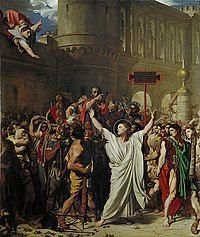St. Symphorianus
| Saints Symphorian and Timotheus | |
|---|---|

|
|
| Martyrs | |
| Died | August 22, 178 |
| Venerated in | Catholic Church |
| Canonized | Pre-Congregation |
| Major shrine | Autun |
| Feast | August 22 |
| Attributes | Symphorian is depicted as a young man being dragged to martyrdom while his mother encourages him. |
| Patronage | Symphorian is patron of Autun; children; students; against eye problems, against syphilis |
Symphorian (Symphorianus, Symphorien), Timotheus (Timothy), and Hippolytus of Rome are three Christian martyrs who though they were unrelated and were killed in different places and at different times, shared a common feast day in the General Roman Calendar from at least the 1568 Tridentine Calendar to the Mysterii Paschalis.
According to a legend of the early 5th century, St. Symphorian of Autun was beheaded, while still a young man, during the reign of Marcus Aurelius. He was the son of a senator named Faustus. He studied at Autun and was brought before the provincial governor Heraclius for not worshipping the pagan goddess Cybele. Symphorian is said to have asked for tools to destroy the statue. He was arrested and flogged and, because he was from a noble family, he was given a chance to recant. Symphorian was offered bribes to do so, but he declined.
His mother, the Blessed Augusta (?), encouraged him on his way to execution, 22 August 178, and was present at her son's death. In the oldest redaction of manuscripts containing the saint's life we find a Gaulish sentence recorded that she allegedly yelled from the city wall: nate, nate, synphoriane, mentobeto to diuo which may be read as "gnate, gnate, mentobe to diwo " "son, son, o synphorian, remember your god!".
According to a legendary passio of St. Benignus of Dijon, Symphorian was a young nobleman who was converted by Benignus at Autun.
Bishop Euphronius (died 490) built a handsome church over Symphorian's grave, connected with a monastery, which belonged to the Congregation of Sainte-Geneviève from 1656 until its suppression in 1791. Abbot Germanus later became Bishop of Paris, where he dedicated a chapel to the saint. Genesius of Clermont built a church dedicated to him at Clermont.
...
Wikipedia
